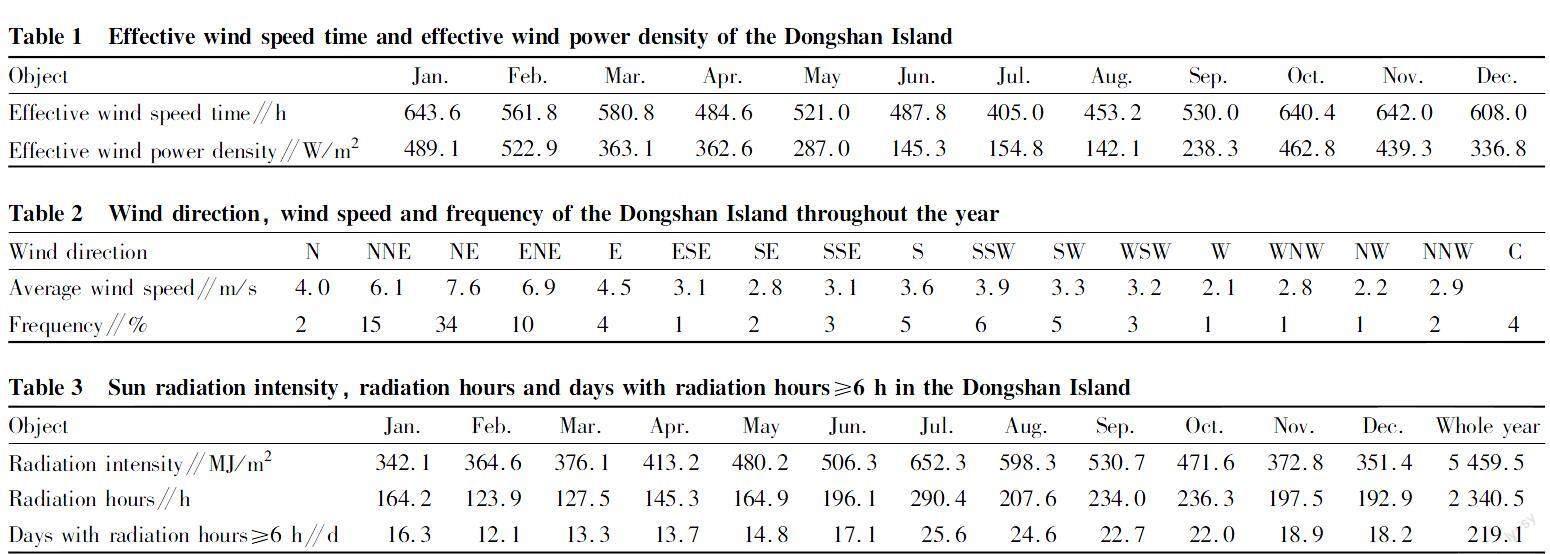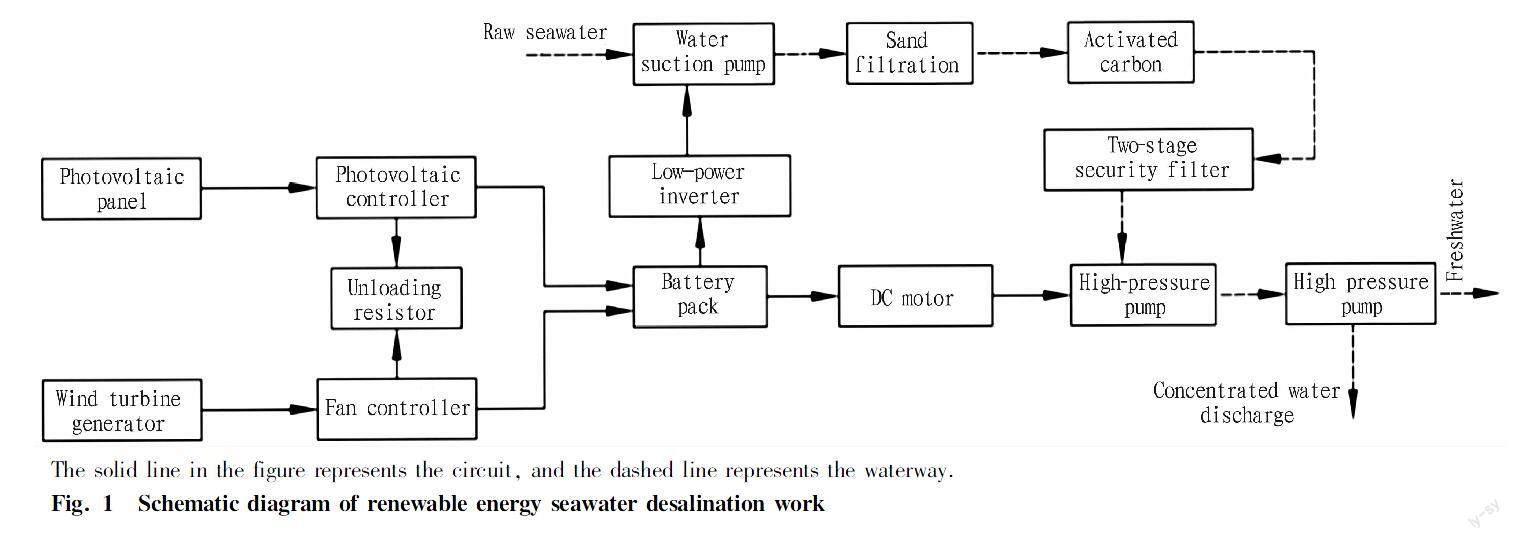Renewable Energy Seawater Desalination Technology and Application Analysis
Guifang HUANG, Guanyuan WEI, Lan DING


AbstractThis paper proposed a new technology way for seawater desalination which used renewable energy (wind energy and solar energy). The effects of practical application showed that remote islands and cage culture zones in the bay that lack electricity and water are very suitable for using small seawater desalination devices that do not require consumption of conventional energy.
Key wordsRenewable energy sources; Seawater desalination; Application
DOI:10.19759/j.cnki.2164-4993.2023.04.021
Both wind and solar energy belong to the category of renewable and clean energy, which is inexhaustible. According to reports, the total amount of wind energy in the world is about 20 billion watts, equivalent to 8 times the total power generation in the world, and solar energy, as a huge renewable energy, reaches the earths surface every day with radiant energy equivalent to the energy obtained from the burning of hundreds of millions of barrels of oil[2]. We have explored and attempted on how to effectively utilize wind energy, solar energy and seawater in remote islands and cage aquaculture zones in the bay, that lack electricity and water. The organic combination and unity of the three is the key technology for utilizing renewable energy for seawater desalination.
Technical Solution Determination
Seawater desalination methods
Seawater desalination refers to the technology and process of obtaining fresh water from seawater[3]. It is a water treatment technology that removes most of salts in seawater to make the treated seawater meet the standards for domestic and production water. Although there are many methods for seawater desalination, the methods, that can achieve commercial scale at present, mainly include the reverse osmosis process and distillation method, which are often referred to as "membrane method" and "thermal method". The reverse osmosis process is the fastest developing seawater desalination technology in the past 20 years. It not only has a wide range of applications, large or small scale, and short construction period, but also has the advantages of no phase change in the desalination process, no need for heating, simple process, low energy consumption, high desalination rate, easy operation and control compared with other distillation methods (multi-stage flash evaporation, multi-effect distillation, and vapor compression distillation). Especially for cage aquaculture zones in the bay, the breeding operation platform for each unit is limited, while the reverse osmosis desalination device has a compact structure and small footprint, which meets its usage requirements. In view of the advantages of the above reverse osmosis process, it is the best choice to use this method for desalinate seawater in remote islands and cage culture areas in the bay.
Renewable energy driving forms
Wind and solar energy, as renewable and clean energy sources, have been increasingly utilized and become the main new energy sources to replace fossil fuels in the future. Wind power generation is the main form of wind energy utilization today. Its principle is to convert kinetic energy of air flow into mechanical energy through impellers, and then convert the mechanical energy of impellers into electrical energy through generators[4]. There are three ways to convert and utilize solar energy: photothermal conversion, photoelectric conversion, and photochemical conversion. Different occasions have different utilization methods. Photoelectric conversion is photovoltaic cells made by applying the principle of photovoltaic effect, which directly converts solar energy into electrical energy for use. Devices that can produce photovoltaic effect are called photovoltaic devices. Semiconductor P-N junction devices have the highest solar-cell efficiency under the sun, and they are usually called photovoltaic cells[2]. Due to the fact that desalination by the membrane method can only utilize electrical energy, it is appropriate to use a complementary combination of wind power generation and photovoltaic power generation as the driving energy for reverse osmosis desalination.
Driving power matching
The renewable energy seawater desalination demonstration project should follow the principle of economic rationality, that is, produce fresh water that meets the Standards for Drinking Water Quality with the lowest investment cost. When formulating the plan, it is necessary to avoid the waste of driving power caused by "big horses pulling small cars", which can increase investment costs, while also taking into account the situation of "small people carrying heavy loads", which cannot enable normal operation and causes intermittent water discharge. Table 1 and Table 2 show the wind energy resources of Dongshan Island in Fujian Province, while Table 3 shows the solar energy resources of Dongshan Island in Fujian Province.
From the table, it can be seen that the Dongshan Island is rich in both wind and solar resources. The annual effective wind speed time (3-20 m/s) reached 6 558.2 h, and the annual wind energy storage capacity reached 2 269 kilowatt hours/m2. The dominant direction was northeast wind, with an average wind speed of 7.6 m/s and a frequency of 34%. The annual average wind speed was above 5.5 m/s. The annual total solar radiation reached 5 459.5 MJ/m2, and the sunshine duration reached 2 340.5 h, and the total days with radiation hours greater than (or equal to) 6 h reached 219.1 d. According to technical information[1], the wind energy utilization coefficient Cp<0.593 is the theoretical maximum value, known as the betz limit. At present, for the conversion efficiency of wind turbines developed in China, the wind energy utilization coefficient of 100 watt wind turbines is less than 0.3, and that of kilopower wind turbines is about 0.4, with a maximum of 0.5. Taking the demonstration project of reverse osmosis desalination with a daily output of 2 t of desalination water as an example, the required driving power configurations are as follows: ① the total power required for the water desalination device is 1.7 kW (including 1.5 kW input power for the desalination machine, 0.15 kW input power for the pump, and 0.05 kW power for the control box); ② the total power consumption of the electrical load is 1.7 kW×12 h=20.4 kWh (the seawater desalination device operates for 12 h per day); ③ the proposed wind turbine has a power generation capacity of 3 kW×1 unit×13.5 h×0.4=16.2 kWh (based on the effective hours in July shown in Table 1, which is the minimum for the whole year, with a daily average of 13.5 h, and the wind energy utilization coefficient is taken as 0.4); ④ the proposed photovoltaic system has a power generation capacity of 0.15 kW×10 pieces×4.43 h=6.65 kWh (based on the radiation hours in February as shown in Table 3, which is the minimum in the whole year, the average daily time of 4.43 h, and 10 pieces of 150 watt photovoltaic panels); ⑤ the total power generation of the wind-solar complementary system is 16.2 kWh+6.65 kWh=22.85 kWh; ⑥ the total power generation is 22.85 kWh and the total power consumption is 20.4 kWh (feasible plan); and ⑦ the battery capacity configuration is 22.85 kWh×103/200 Ah×12 V=9.5 units (each battery has a storage capacity of 12 V, 200Ah).
Technical process route
The reverse osmosis demonstration project with a daily output of 2 t of desalination water requires a 3 kW wind turbine and 10 pieces of 150 watt photovoltaic panels to drive the energy system, providing a continuous source of power to the reverse osmosis seawater desalination device. The output voltage of the wind turbine is 110 V (DC), and the output voltage of each photovoltaic panel is 16.5 V (DC). The total output voltage of 10 photovoltaic panels installed in series is 165 V (DC) (to prevent reverse charging, the voltage should be higher than the battery voltage). The battery pack consists of 9 batteries (12 V, 200 Ah) installed in series, with an output DC voltage of 108 V. Due to the harsh working environment at sea, high-power electronic components and equipment that are prone to heat generation are affected by moisture and salt mist erosion, resulting in a high frequency of short circuits and faults. Therefore, high-power inverters should not be used. Instead, it is safer and more reliable to directly use 110 V DC motors to drive high-pressure pumps on fishing rafts. The seawater desalination process uses a water suction pump (with a lift of 30-40 m) to draw the raw seawater from the nearby area, which is then subjected to sand filtration, activated carbon adsorption, two-stage security filtration and fine filtration (with filtration accuracy of 10 and 5 μm). It is then sent to a high-pressure pump (with a working pressure of 4-6 MPa) to enter the reverse osmosis membrane to produce fresh water. Fig. 1 shows the working principle and process route of the entire renewable energy seawater desalination system.
Agricultural Biotechnology2023Application Case Analysis
Desalinated water demonstration project in a cage aquaculture zone in the bay with daily production of 10 t
The demonstration project is built in Qixia cage aquaculture zone, Chencheng Town, Dongshan County, to provide fresh water for daily drinking for farmers around the demonstration site. If 60 L of fresh water is consumed per person per day, it could basically supply about 160 people with domestic water. The demonstration project adopts full-wind reverse osmosis seawater desalination, using 6 sets of 3 kW wind turbines and 2 sets of desalination water devices with a daily output of 5 t, installed at 15 m×15 m floating raft platform, forming an offshore freshwater supply station. The floating raft platform is composed of a hardwood frame, wooden boards, and floating materials. The area of the floating raft platform is determined by the number of wind turbines installed, and its structure and strength should be able to withstand the platforms own weight and the total weight of water storage tanks (full of water) and all equipment, to ensure that the equipment could operate safely and normally. In normal working conditions, the floating raft platform is tied and anchored next to the cage. When a typhoon approaches, the mooring rope is unfastened and the work boat is towed to a safe haven to avoid the typhoon, ensuring the safety of the installation. Due to the lack of shelter or obstacles around the cage aquaculture zone in the bay, the utilization of wind energy resources is unique. Therefore, providing power to seawater desalination devices with pollution-free zero-operating cost wind energy is undoubtedly the best choice.
Island desalinated water demonstration project with daily production of 10 t
The demonstration project is built in Dongmenyu, Dongshan Island, to provide fresh water for daily life for the staff of Dongmenyu Forestry Management Office in Dongshan County and tourists in the scenic spot. The demonstration project adopts full wind reverse osmosis seawater desalination. Six sets of 3 kilowatt wind turbines are installed at the top of mountains with abundant wind resource on the island, with a horizontal distance between adjacent wind turbines not less than 5 times the diameter of the wind blades (with a diameter of 3 m). Two sets of desalinated water devices with a daily output of 5 t are installed in the machine room at the seaside below the mountains for ease of water intake. Due to the distance of 600-700 m between the wind turbine cluster and the desalination machine room, two issues need to be addressed. First, the long transmission line will cause power loss, and second, when a typhoon strikes, the wind turbine controller installed in the seaside machine room at the foot of the mountains will reduce the reliability of wind turbine brake due to the long line. A relatively simple and practical measure is to use wires with larger diameters as much as possible while reducing the transmission cost of the line; and a waterproof electric control box is installed at the root of each fan column. If a typhoon strikes, the switch will be turned off in the waterproof electric control box in advance to provide safety assurance for the reliable braking of the fan.
Fishing raft desalinated water demonstration project with daily production of 2 t
The demonstration project is built on the fishing rafts in the cage culture area of the island opposite to Tongling Town, Dongshan County, to provide fresh water for daily life of farmers in one unit (with 200-400 cages). The demonstration project adopts wind and solar complementary reverse osmosis seawater desalination. One set of 3 kilowatt wind turbine is directly installed on the hardwood beams of fishing rafts, and 10 sets of 150 watt photovoltaic panels are installed on the roof of the fishing raft management room. The devices that produce 2 t of desalinated water per day is placed in a corner of the management room, without occupying too much fishing raft area and affecting fishermens marine aquaculture operations. The construction of the demonstration project brings real benefits to net cage farmers who lack electricity and water. Previously, a person should be assigned to drive a boat to a freshwater supply station on the shore every day to buy water, which was both costly and labor-intensive. Now, not only can local materials be used to produce standardized desalinated water, but also at night, inexpensive electricity can be used to provide lighting, make tea, and watch TV, enriching fishermens leisure cultural life.
Conclusions
Water resources are one of the material foundations for the survival and development of human society. With the increase of world population and the change of human life style, the scarcity of freshwater resources has attracted more and more attention. China is generally a country with water shortage, having a population of more than 20% of the world population, but water resources only account for 6%. The lack of water resources has seriously hindered Chinas economic development and damaged the ecological environment. Seawater desalination, as an open-source incremental technology, has become an important way to solve water resource problems. Utilizing renewable energy for seawater desalination is a new environmentally-friendly approach to resource conservation. The preliminary experimental results of three demonstration projects indicate that the use of wind and solar energy for reverse osmosis seawater desalination technology is practical and feasible. The systems are safe and reliable in operation, pollution-free, easy to maintain, and do not consume conventional energy such as oil, natural gas, and coal. They are widely welcomed by fishermen, and have more promotion value and application prospects especially for isolated islands and fishing rafts that lack electricity and water.
References
[1] LIU WK, ZHANG ZY, LI YF, et al. Wind energy and wind power generation technology[M]. Beijing: Chemical Industry Press, 2007. (in Chinese).
[2] ZHAO ZM, LIU JZ, SUN XY, et al. Solar photovoltaic power generation and its applications[M]. Beijing: Science Press, 2005. (in Chinese).
[3] GAO CJ, CHEN GH. Handbook of seawater desalination technology and engineering[M]. Beijing: Chemical Industry Press, 2004, (in Chinese).
[4] LI J, TAO RJ. Overview of wind energy seawater desalination[J]. Water Purification Technology, 2008, 27(1): 9-11. (in Chinese).
[5] GAO CJ, CHEN GH. A comprehensive investigation and research report on island resources in Fujian Province[M]. Beijing: China Ocean Press, 1996. (in Chinese).
Editor: Yingzhi GUANGProofreader: Xinxiu ZHU
- 农业生物技术(英文版)的其它文章
- Optimization of Extraction Conditions for Total Flavonoids from Fructus Aurantii Immaturus and Its Anti-UVB Radiation Activity
- Research on Maize Seed Classification Method Based on Convolutional Neural Network
- Common Species Distribution Models in Biodiversity Analysis and Their Challenges and Prospects in Application
- Vegetable Tunnel House Technology in Tropical Island Countries
- Purification and Characterization of Hyaluronate Lyases Produced by Two Types of Bacteria
- Impact of Water Quality Sampling Process on Environmental Monitoring Results

